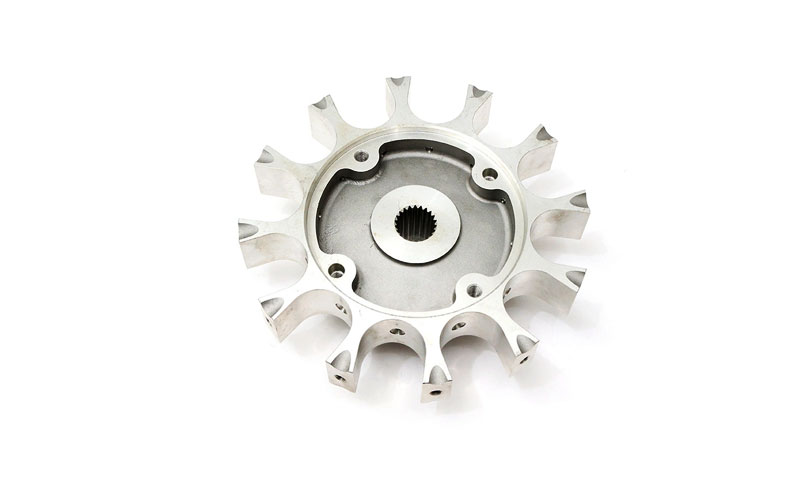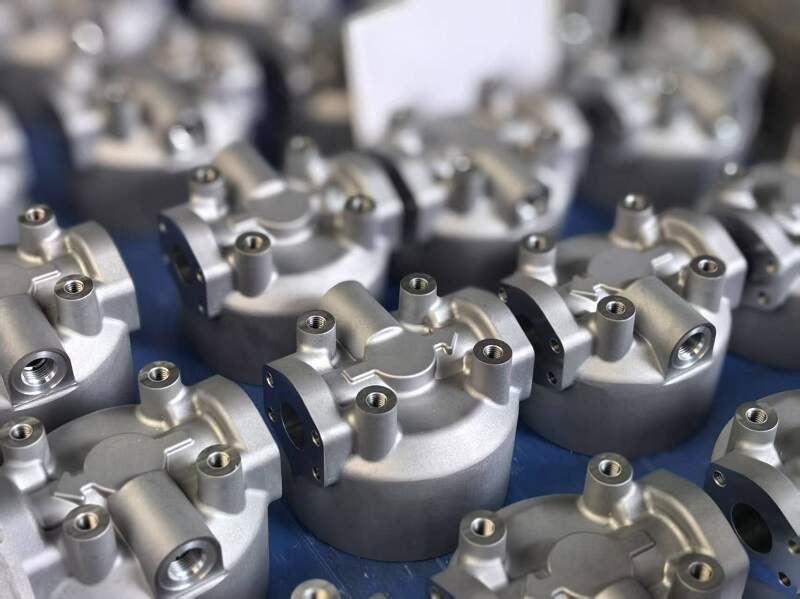Aluminum Casting Explained: Secret Realities and Insights for Industry Professionals
Aluminum casting functions as a vital process in modern-day manufacturing, forming components throughout various fields. Its diverse approaches, such as sand and die casting, accommodate various manufacturing requirements. The one-of-a-kind residential or commercial properties of aluminum alloys improve their applicability, yet tests stay in keeping top quality and efficiency. Comprehending these facets is necessary for market professionals. What are the current developments and best methods that can additionally optimize this procedure?
Review of Aluminum Casting Processes

Key elements of aluminum casting processes include the prep work of mold and mildews, which might be made from sand, metal, or ceramic materials, depending on the intended usage. In addition, temperature control is crucial to guarantee correct melting and solidification of aluminum.
The casting process enables for intricate styles and can achieve high degrees of dimensional precision. Once cooled down, the castings may undertake ending up operations such as machining or surface therapy to satisfy particular performance requirements. In general, aluminum casting offers as a functional manufacturing strategy, efficiently fulfilling the diverse demands of different sectors.
Types of Aluminum Casting Approaches
In the domain of aluminum casting, different techniques are utilized to accomplish various results. Sand casting methods give versatility and cost-effectiveness for complicated forms, while die casting procedures offer high precision and performance for mass manufacturing. Understanding these methods is crucial for choosing the ideal method based upon project requirements.
Sand Casting Methods
Sand casting methods stand for a fundamental approach in aluminum casting, where sand is used as a mold and mildew product to shape molten steel. This process includes developing a pattern from the desired part, which is then positioned in a sand combination to develop a mold and mildew. The sand is compacted around the pattern, and after elimination, it develops a tooth cavity in the form of the part. Molten aluminum is poured into this tooth cavity, permitting it to cool and solidify. One considerable benefit of sand casting is its flexibility; it can fit complicated forms and big parts. Furthermore, the products made use of are reasonably cost-effective, making it an easily accessible alternative for numerous manufacturing applications in the aluminum industry.
Die Casting Processes
Die casting processes are a famous technique for shaping aluminum parts, using high-pressure methods to compel liquified steel into exactly engineered molds. This process is especially preferred for its capacity to generate intricate forms with limited resistances and a smooth coating. There are 2 main kinds of die casting: warm chamber and cool chamber. Warm chamber die casting is appropriate for metals with low melting factors, permitting faster manufacturing rates. Conversely, cool chamber die casting is optimal for greater melting factor steels, requiring a different melting heater. Both techniques improve effectiveness and lower material waste, making them crucial in vehicle, aerospace, and customer items sectors. Comprehending these processes aids professionals choose the most appropriate strategy for their certain applications.
Product Feature of Aluminum Alloys

Strength and Resilience
Stamina and durability are important attributes of aluminum alloys that make them appropriate for different casting applications. These products show a beneficial strength-to-weight proportion, permitting the development of light-weight yet durable components. When it come to tensile stamina, certain aluminum alloys can be crafted to hold up against considerable loads without flawing. This building is particularly essential in markets such as aerospace and vehicle, where efficiency and safety and security are paramount. Additionally, aluminum alloys usually maintain their mechanical properties under diverse temperature conditions, guaranteeing constant performance. The intrinsic ductility of these alloys additionally permits for reliable shaping throughout the casting procedure, making it less complicated to generate intricate geometries. Overall, the strength and resilience of aluminum alloys contribute significantly to their extensive use in innovative applications.
Deterioration Resistance Characteristics
While aluminum alloys are valued for their strength and lightweight properties, their deterioration resistance is an additional crucial quality that enhances their viability for different applications. Aluminum normally develops a safety oxide layer when revealed to wetness, which helps to stop more oxidation. This intrinsic building makes aluminum alloys particularly valuable in atmospheres prone to rust, such as industrial and marine setups. Furthermore, different alloy structures can influence resistance degrees, with certain alloys specifically engineered to improve this characteristic. Treatments like plating can additionally improve rust resistance by enlarging the oxide layer. Comprehending the deterioration resistance of aluminum alloys is vital for sector experts when picking materials for jobs needing resilience and durability in tough environments.
Advantages of Aluminum Casting in Production
Aluminum casting deals various benefits in production, making it a preferred option for numerous industries. One considerable advantage is its light-weight nature, which contributes to decreased transport expenses and enhanced power performance in end products. Furthermore, aluminum's exceptional thermal and electric conductivity enhances functionality in applications requiring warmth dissipation or electric transmission.
The material's ability to be cast into intricate shapes allows for style versatility, minimizing the demand for extra machining processes. Furthermore, aluminum casting displays remarkable deterioration resistance, leading to longer item life-spans learn this here now and reduced upkeep costs.

Usual Applications of Aluminum Castings
The versatility of aluminum casting enables its extensive usage throughout numerous markets. Typical applications consist of vehicle parts, where light-weight and corrosion-resistant elements, such as engine blocks and transmission housings, improve lorry efficiency. In the aerospace market, aluminum castings are used for structural elements, using toughness without adding considerable weight.
In addition, the electric industry advantages from aluminum castings in producing rooms and warmth sinks, where thermal conductivity is vital. The durable goods field additionally integrates aluminum castings in products like kitchenware, furnishings, and decorative items, integrating aesthetic appeals with performance.
In addition, the building and construction sector utilizes aluminum spreadings for architectural aspects, home window frames, and components, which provide toughness and layout adaptability. Overall, the varied applications of aluminum spreadings highlight their value in contemporary manufacturing, contributing to advancements in efficiency and item style across several fields.
Developments and Technological Innovations
As markets remain to evolve, innovations in aluminum casting modern technology are changing manufacturing procedures and product capacities. Innovations in 3D printing and additive production have enabled the production of complicated geometries that were previously impossible to read the article achieve with traditional approaches. These modern technologies enable fast prototyping, decreasing preparations and expenses.
Additionally, improvements in mold and mildew design and materials have boosted the casting procedure by boosting efficiency and lowering waste. The combination of wise production methods, such as IoT tools and real-time data analytics, allows for much better monitoring and optimization of manufacturing specifications, causing better outputs.
Growths in aluminum alloys offer boosted strength, rust resistance, and light-weight homes, providing to the growing demands in aerospace and automobile fields. Collectively, these advancements are not just improving productivity however likewise fulfilling the strenuous criteria of contemporary design applications.
Ideal Practices for Top Quality Control in Aluminum Casting
Making sure top notch results in aluminum casting calls for adherence to best practices that include different stages of the production procedure. Initially, thorough material inspection is vital to confirm the high quality of aluminum alloys used, as pollutants can substantially influence the last item. Implementing specific melting and More Help putting methods reduces flaws; preserving ideal temperature levels avoids oxidation and advertises uniformity.
In addition, mold and mildew style plays an important function; using computer-aided design (CAD) can boost accuracy and reduce human mistake. Routine monitoring of the cooling procedure is vital to prevent warping and contraction. In addition, making use of non-destructive testing methods, such as ultrasonic or X-ray examinations, assists determine internal problems without harming the components.
Establishing a feedback loop with operators and designers promotes continuous renovation, guaranteeing that high quality control actions develop alongside technical developments. By adhering to these ideal practices, producers can boost the integrity and efficiency of aluminum castings.
Often Asked Inquiries
What Are the Environmental Effects of Aluminum Casting?
The ecological impacts of aluminum casting include considerable power intake, greenhouse gas discharges, and potential water contamination from shop operations. Furthermore, bauxite mining for aluminum ore can cause environment devastation and dirt destruction.
Exactly How Does Aluminum Casting Contrast to Various Other Steel Casting Procedures?
Aluminum casting generally provides advantages in lightweight components and corrosion resistance compared to various other procedures, such as iron or steel casting, which might provide greater stamina however lead to larger and much less corrosion-resistant items. - Aluminum Casting Company
What Prevail Defects in Aluminum Castings and Their Causes?
Common problems in aluminum castings include porosity, shrinking, and additions. Causes commonly come from incorrect putting techniques, inadequate mold design, or contamination of the molten steel, influencing the end product's integrity and performance.
What Safety and security Precautions Should Be Taken During Aluminum Casting?
Throughout aluminum casting, necessary security precautions consist of using protective equipment, making sure appropriate ventilation, maintaining a tidy office, dealing with liquified steel with care, and adhering to well established protocols to decrease dangers of burns, breathing threats, and mishaps.
How Can I Boost the Effectiveness of My Aluminum Casting Procedures?
To enhance efficiency in aluminum casting procedures, one should enhance mold design, simplify material handling, use automated processes, perform regular upkeep on equipment, and buy staff member training to improve skills and performance.
Numerous methods exist, aluminum casting incorporates a number of primary processes that provide to different applications and requirements. Secret elements of aluminum casting procedures include the prep work of molds, which might be made from sand, steel, or ceramic products, depending on the intended use. Sand casting methods represent a basic technique in aluminum casting, where sand is used as a mold material to shape molten metal. As sectors proceed to evolve, technologies in aluminum casting technology are transforming manufacturing procedures and product capabilities. Ensuring top notch results in aluminum casting needs adherence to finest techniques that encompass different phases of the production process.